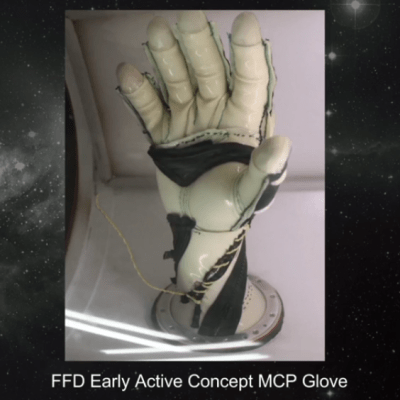What will next generation space suits look like? Kari Love is making the case that new space suits will exhibit the best in soft robot technology. The problem is that most people don’t really understand much about soft robots, or about space for that matter. Her talk at the Hackaday SuperConference explores the research she has been doing into future generations of space suits. Check out the video below and then join us after the break for more on this topic.
I’ll be honest, I haven’t been very excited about soft robotics. Kari Love is right when starting her talk and mention that this is because most people don’t understand the field. Having seen the problems that these soft designs can address, and the applications currently under research, I’ve changed my tune. This is a fascinating field that’s worth your time for a deep dive.
Soft robots come from a medical background which looked for ways that robots could more closely work with humans without risks of injuring them. They are inspired by nature; most moving things are soft (or soft and hard together) but most of human robot engineering is hard by nature. It’s no wonder that it’s super difficult to develop humanoid robots when their physiology has so little comparison to our own. Kari shows off an overview of some biological successes like the leg “design” of goats and early work at engineering bio-inspired solutions. Robot feet that combine hard and soft components are better at adapting to rough terrain, much like what all walking beasts already incorporate.
 Applying this understanding to space suits, the picture begins to become clear. Current space suit gloves are like over-engineered balloons. The pressure keeping the suit inflated resists astronauts closing their hands and otherwise moving. The inflated balloon issue makes suits bulky and punctures dangerous.
Applying this understanding to space suits, the picture begins to become clear. Current space suit gloves are like over-engineered balloons. The pressure keeping the suit inflated resists astronauts closing their hands and otherwise moving. The inflated balloon issue makes suits bulky and punctures dangerous.
Current research is exploring a topic that is already half a century old: mechanical counterpressure. It’s still a soft robot, but it’s not an inflatable robot. Instead of putting a balloon between the human body and the vacuum of space, the suit itself is engineered to closely follow the body and exert pressure — think elastic bands — in just the right places.
It’s a really difficult problem, but done correctly there are myriad benefits. The weight and bulk of such a system will be orders of magnitude less which is a tremendous benefit when launching it into space, and it could improve mobility for the person wearing it. The challenges with soft spacesuits are not likely to be solved all at once — how do you build in a gasket to connect to a helmet, and what about dealing with breathing movements without constricting the rib cage? But Kari and others are working on the beginnings of the system by developing new glove designs. These will interface with current EVA suits, allowing early problems to be solved by providing dexterity in the place where it is most needed.
She concludes her talk with a few more examples of NASA-funded soft robots that aren’t related to suits. We definitely need space squids, right? This makes a lot of sense: exploring the moon Europa requires a swimming robot. If you currently don’t have enough nightmares about robots, you’ll enjoy some of the soft-robot rover designs — the actual prototypes exist and their fly-inspired designs can crawl up and cling to inhospitable environments. And the vision of soft/hard hybrid bots that can be dumped directly from orbit to swarm across the surface of celestial bodies reminds me of Theo Jansen’s visions.
I want to close with my favorite quote from Kari’s talk: “Don’t underestimate a goat as a control system”.
















Well I would have thunk resistance to movement would be medically beneficial, considering how they worry that long missions cause muscle wasting and heart weakness etc.
But it makes all your tasks many times harder. Simply moving is harder than you’re used to which makes long EVAs extremely taxing on the astronaut.
If you rewatch the Apollo moon walks, you see how hard it is for them to move around or stand back up from a fall. Part of the trouble is that the resistance is in every direction, not just the directions you’re used to moving. It requires every minor muscle to move together which it may not be used to even in fit individuals.
Holding your arm or leg in a position now becomes a constant struggle rather than just the effort to move to a new position.
Lack of dexterity becomes a huge issue in regards to construction and repair. The tools used in space are mostly adapted or specially designed for use in a space suit, adding cost and size. With a high dexterity glove, an astronaut could use more common and less bulky tools, as an example, and likely be able to perform certain tasks quicker and more accurately.
Awesome spacesuit design lecture! #SpacesuitUp!
Some Women have beauty, and grow large. But can always change their lifestyles…
Some men are ugly, and it goes all the way through to their loneliness.
If she can dance, I’d date her…
“And what about dealing with breathing movements without constricting the rib cage?”
Seems that this could be solved by pairing a balloon type torso with mechanical counterpressure limbs. That should be workable for everything except Hollywood, who will be disappointed in how it doesn’t flatter their stars’ figures.
Add mechanical manipulators on the ends of the arms and you no longer need the gloves. That way you can have dexterous metal fingers doing the actual manipulation instead of stubby rubber covered ham-hands that are inconvenienced by the protective layers.
You get to keep your hand “in the sleeve” and the mechanical hand does the work. No need to worry about puncturing a glove or crushing your fingers – and you can augment yourself such as by adding specialty bits like 360 degrees rotating wrist.